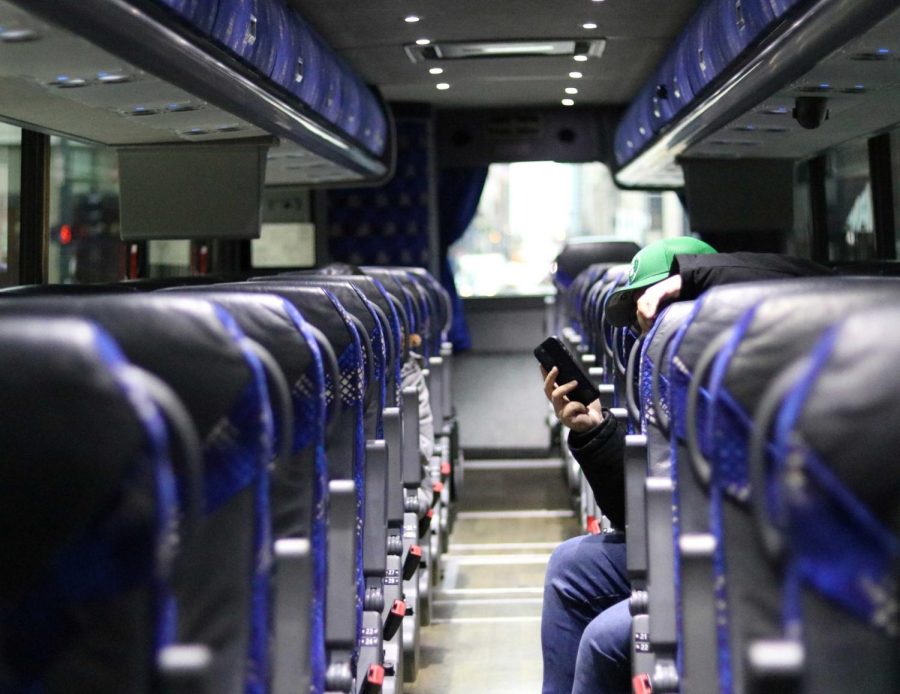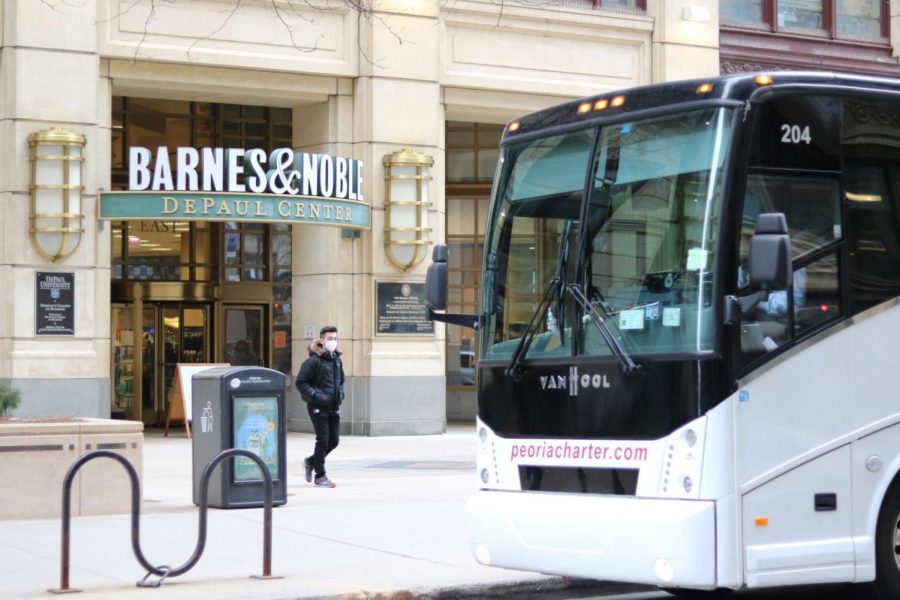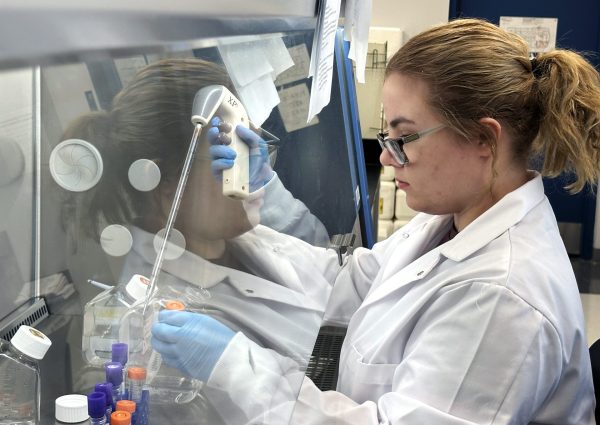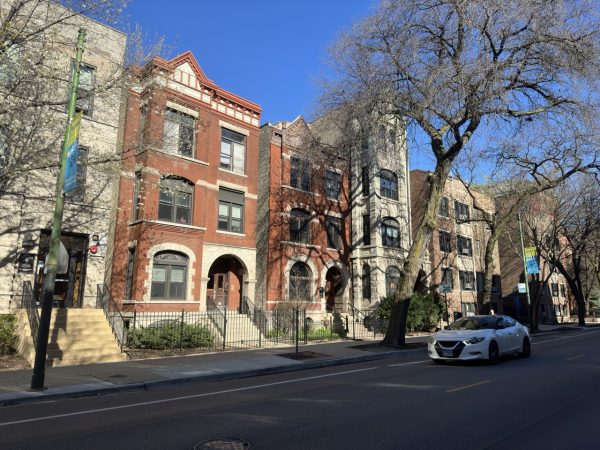The wheels on the bus: New shuttle service shuffles students between campuses
One of DePaul’s shuttle buses waits in front of DePaul Center, its designated pick-up location on the Loop campus.
For the first time in DePaul’s history, the university is piloting an intercampus shuttle bus program between the Lincoln Park campus and the Loop campus.
There are three shuttle buses available to students, two of which are handicap accessible, according to Newsline. Students must show their student ID when boarding the bus.
The shuttle bus program runs Monday through Thursday from 4 p.m. to 10 p.m. until the end of the quarter on June 10, according to Newsline.
Student Government Association (SGA) and Facility Operations worked together to implement the program following the Public Safety Town Hall on March 2, said SGA Executive Vice President of Operations Kellen Brown.
Director of Public Safety Bob Wachowski said at the town hall that he “did not have the resources” to create a shuttle bus program for students.
“The university and Facility Operations were given the resources to do [this],” Brown said.
Students spoke at the town hall on March 2 about safety concerns after crime at the Jackson Red Line stop and commuting in the evening.
“[The facility operations staff] probably recognized the need for [the shuttle buses] already, but the student concerns definitely really pushed it forward,” Brown said.
The shuttle buses run approximately every 30 minutes, according to SGA Vice President Kevin Holechko. There is no exact timetable that is available to students, but the bus drivers have a general timetable they follow, Holechko said.
Students have experienced crime at the Jackson stop, but many did not report their experiences to authorities, According to previous reporting,
Lenin Plazas, SGA Senator for Commuter Affairs, said he wanted students to have a safer commuting option when going to their classes.

“Of course, it’s always a priority to make sure that [transportation is] accessible to all students, make sure that all students feel comfortable, and they feel like they’re not a burden or that they have the liberty to go on these buses with no hesitation,” Plazas said.
The buses run directly between both campuses, whereas the CTA could experience delays.
“[The CTA] have their delays, they have their fair share [of] signal clearances, and they get [people] to classes late,” Plazas said. “Whereas the shuttle buses hopefully don’t have a lot of signal clearance issues. So it’s mainly for the entire student body, but in my mind, it’s also for commuter students who are just tired of the CTA. If they want to take a safer, maybe more direct approach, make sure they’d be there on time.”
There has been an increase in student demand for safer modes of transportation to the Loop campus since early March at the SGA Public Safety Town Hall. The administration’s implementation of safer transportation through the shuttle buses made students pleasantly surprised, Plazas said.
“[A friend of mine] said [the shuttle bus] was really convenient and he was almost kind of surprised like ‘Wow, it’s like DePaul is really starting to invest in these things,’” Plazas said. “He was really happy that DePaul took notice and I think he’s still kind of in shock [at] how convenient it is now that he could reduce that long walk.”
The buses all have free Wi-Fi and students can do homework while commuting.
“If you’re really running behind on an assignment, you can now do it on the bus going down, or back and forth between campuses,” Holechko said.
Brown, Plazas and Holechko have received overall positive feedback about the buses.
Junior Beemnet Desta rode the bus on Wednesday afternoon.
“[The shuttle buses are] a good idea, especially for freshmen and taking classes at night,” Desta said.
Senior Aya Hajissa said the experience of riding the shuttle bus was more relaxing than the CTA.
“[The shuttle buses are] way better than taking any of the trains,” Hajissa said.
Holechko said students were concerned that there was no DePaul affiliation labeled on the buses.
“I’ve talked with [students and] the two big complaints I’ve gotten was that the bus itself doesn’t say anything DePaul related,” Holechko said. “So I know a lot of the students that were getting on [the bus] were like, ‘Is this that DePaul bus?’ And the bus driver was like, ‘Yes, this is me.’”
As of Wednesday night, Facility Operations staff members were made aware of the concern, Brown said. There is now DePaul affiliated signage on the shuttle buses, according to Brown.
Although it is a pilot program, there could be room for expansion into the fall quarter. However, Plazas said SGA wants to be conscious of other factors such as environmental sustainability.
“I don’t want there to be excess in buses because I know that that’s been an issue,” Plazas said. “The senator for sustainability, [Lameka Hayes], has mentioned that she wants to make sure that our safety alternatives are also environmentally friendly. We want to make sure that all of our shuttle buses don’t disrupt the Lincoln Park community and downtown [community].”
If students are using the shuttle service more than the CTA, they could opt out of the U-Pass.
“I was riding with one of my friends on the bus that day and he was like, ‘I might consider canceling my U-pass, because all my classes are in the evening,’” Holechko said. “He’s like the shuttle service runs in the evening, there’s really no need for me to have my Ventra card now because I can just take the shuttle service.”
SGA administration said that they want to provide more accurate timetables to match shuttle trips with when classes get out.
“For the first few weeks, it’s going to be tweaking the system here and there on what’s the most effective way to pick up students,” Holechko said. “[The bus driver] was telling me that the [timetables] were giving them too much time [at one stop] and then sometimes too little because they would be sitting for 25 minutes to 30 minutes, and no one was on the bus at all.”
















Carol • Apr 11, 2022 at 8:21 am
I think the shuttle bus is a fantastic idea. It’s about time crime on the red line is taken seriously. Another Chicago university has had this in place for years. I think DePaul is doing a great job considering the safety of students, especially at night.
confused • Apr 4, 2022 at 11:25 am
i still dont understand why this was necessary to invest in over literally anything else. “there wont be delays” so i guess traffic doesn’t exist anymore? theres already red line stops directly on both campuses and u passes included in tuition. the jackson stop is practically on the loop campus so any crime that happens there is still going to happen around students. i guess the wifi is nice but is that worth all this?